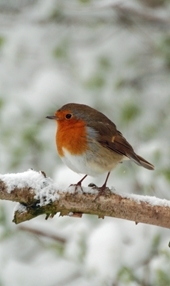In a tradition dating back to the Victorian era, the image of robin on a Christmas card has been part of our festivities for so long that it is now commonplace. At the GWCT demonstration farm in Leicestershire the sight of this striking bird is also familiar as numbers are now at their highest level for 24 years. 
Professor Chris Stoate, Allerton Project Head of Research, comments, “Robins are one of our most widespread and abundant species, occurring in woodland, on farms, and in urban gardens. They have fared particularly well at the Allerton Project, where we have restored predator control and winter feeding in recent years.”
During the last 24 years, the GWCT team at the Allerton Project has witnessed significant changes to breeding numbers. Between 1992 and 2001, numbers doubled when the GWCT carried out a combination of habitat improvement, legal predator control and winter feeding. In contrast, there was a 24% decline in 2006 when predator control was absent, in line with other species whose nesting success and breeding numbers are influenced by the control of nest predators.
The absence of winter feeding as well as predator control saw a further decline in numbers in 2010. Robins are regular visitors to garden bird tables, and have also frequently been recorded using gamebird feed hoppers at the Allerton Project. Trailcam records even document robins feeding from hoppers at night, when the big eyes which are no doubt part of the robin's popular appeal, are put to good use.
Professor Stoate continues; “The research we have undertaken at the Allerton project has enabled us to identify the conservation management systems that need to be in place for species such as the robin to thrive. Farmers and landowners can apply these methods through initiatives such as the Countryside Stewardship Scheme. Each Christmas we demonstrate the cultural value we attach to robins, but the importance of this species, and countless others, extends much further. The robin is a seasonal reminder that, at times of political and economic uncertainty, arguably above all others, our wildlife is an asset which we need to recognise and support for our mutual benefit.”
Notes to editors
The Game & Wildlife Conservation Trust is an independent wildlife conservation charity which carries out scientific research into Britain’s game and wildlife. We advise farmers and landowners on improving wildlife habitats. We employ 22 post-doctoral scientists and 40 other research staff with expertise in areas such as birds, insects, mammals, farming and statistics. We undertake our own research as well as projects funded by contract and grant-aid from Government and private bodies. The Trust is also responsible for a number of Government Biodiversity Action Plan species and is lead partner for grey partridge and joint lead partner for brown hare and black grouse.
The GWCT’s Allerton Project: The GWCT’s Allerton Project is an 800 acre commercial farm business attached to a Research and Educational charitable trust. The Project was established in 1992 with the objective of demonstrating how modern efficient farming and environmental conservation can co-exist. The development of the education objectives of the Trust has expanded substantially to several thousand visitors a year including school groups, politicians and farmers, thus necessitating the construction of a larger visitor centre. The challenge of converting a disused brick cowshed into a sustainable building was given to architect Sylvester Cheung from Melton Mowbray. 60 per cent of construction costs were obtained as a grant from the Rural Development Programme for England.